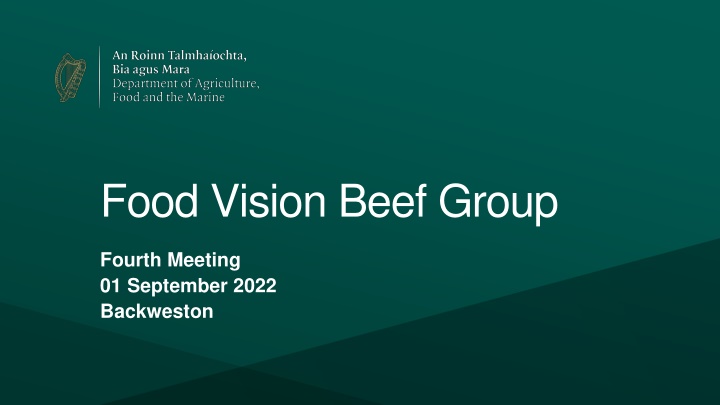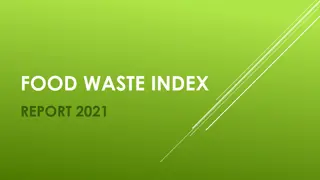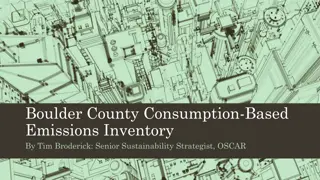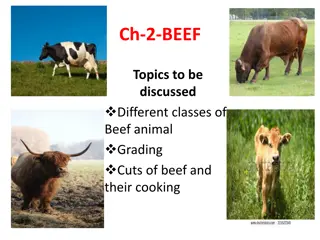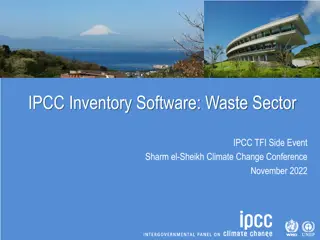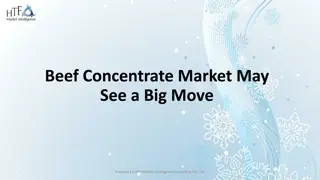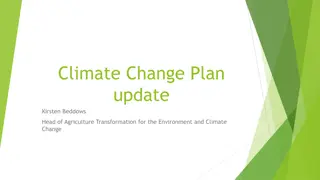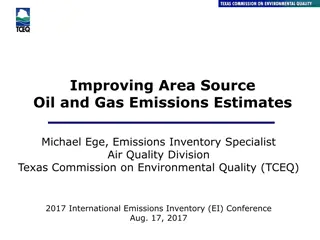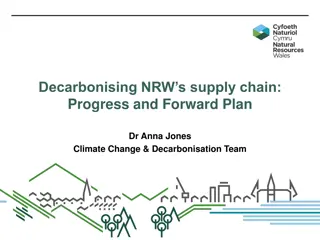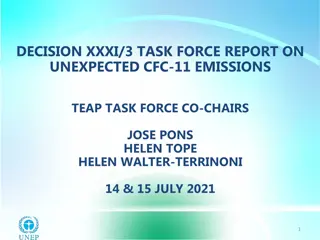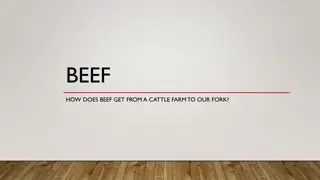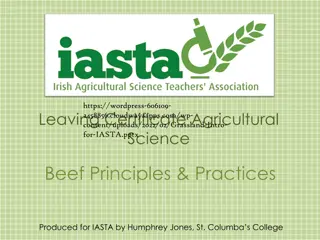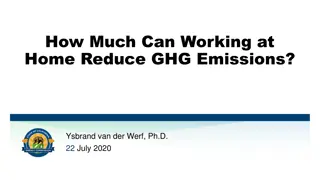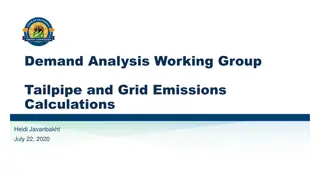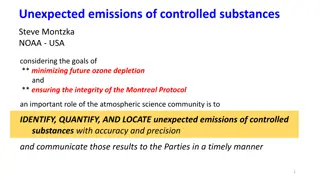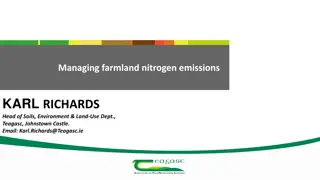Reducing Emissions in the Beef Sector: Draft Report from Food Vision Beef Group Meeting
Draft report from the Food Vision Beef Group's fourth meeting on September 1, 2022, at Backweston focuses on planning to reduce emissions associated with the beef sector. The report contains 17 measures derived from discussions held over the past two months.
Download Presentation

Please find below an Image/Link to download the presentation.
The content on the website is provided AS IS for your information and personal use only. It may not be sold, licensed, or shared on other websites without obtaining consent from the author.If you encounter any issues during the download, it is possible that the publisher has removed the file from their server.
You are allowed to download the files provided on this website for personal or commercial use, subject to the condition that they are used lawfully. All files are the property of their respective owners.
The content on the website is provided AS IS for your information and personal use only. It may not be sold, licensed, or shared on other websites without obtaining consent from the author.
E N D
Presentation Transcript
Food Vision Beef Group Fourth Meeting 01 September 2022 Backweston
Aim: plan for how emissions associated with the beef sector can be reduced. Draft Report: contains a list of 17 measures extracted from discussions over the last two months. Interim Report: will reflect our discussions today and any written observations on this draft, this is also the opportunity to propose any additional specific measures not already reflected in the draft. Final Report: will be framed around a quantification of potential impact for each measure, and actions and resources required to achieve implementation and adoption. 2 An Roinn Talmha ochta, Bia agus Mara | Department of Agriculture, Food and the Marine
Next Steps 9thSeptember circulation of updated draft based on today s discussion and any obs received by cob 6th September. 15thSeptember virtual meeting of the FV Beef Group 16thSeptember Final draft circulated for agreement by written procedure. 23rdSeptember Deadline for final comments w/c 26thSeptember Interim report submitted to Minister McConalogue 3 An Roinn Talmha ochta, Bia agus Mara | Department of Agriculture, Food and the Marine
Structure of First Draft of Food Vision Beef Group Interim Report I. INTRODUCTION II. DATA AND ANALYSIS III.PROPOSED MEASURES IV.NEXT STEPS V.APPENDICES 4 An Roinn Talmha ochta, Bia agus Mara | Department of Agriculture, Food and the Marine
Direct Impact measures to mitigate Greenhouse Gas Emissions from the beef sector
Proposed Measures A. Direct Impact measures to mitigate Greenhouse Gas Emissions from the dairy sector Measure Measure 1 Reduce age of slaughter Measure 2 Reduce age of first calving Target GHG Timeframe Medium/Long Medium/Long CH4 CH4 Measure 3 - Development of methane-mitigating feed technologies CH4 Short/Medium Measure 4 - Target a X% replacement rate of CAN with Protected Urea by the end of 2025 for grass-based beef production systems Measure 5- Reduce chemical N use in the beef sector N2O Short-term N2O Short-term Medium-term Short-term Short term Short-term Medium-term Measure 6 Increase Organic Production Measure 7 Voluntary Exit/Reduction Scheme Measure 8 Explore the potential of Cap and Trade methane-focused emissions model N2O All CH4 Measure 9 Development of methane mitigating Breeding Strategies CH4 Short-term (EF) Medium-Long term (DI) 6 An Roinn Talmha ochta, Bia agus Mara | Department of Agriculture, Food and the Marine
Measure 1 Reduce age of slaughter Impact on Inventory Enabling Factor/ Direct Impact: Direct Impact: Teagasc research shows that the variance between 28 month and 23 month finishing systems is in the region of 1T of CO2e per head. Recommendation Move to average 24-27 months range target in the Climate Action Plan. The average age of slaughter was 30 months in 2010, which declined to 27 months in 2020 and is currently closer to 26 months. Average slaughter age is thus currently approaching target range of 24-27 months set out in the Climate Action Plan. 7 An Roinn Talmha ochta, Bia agus Mara | Department of Agriculture, Food and the Marine
Measure 2Reduce age of first calving Impact on Inventory Enabling Factor/ Direct Impact: Direct Impact Teagasc research shows that reducing age at first calving from 36 to 24 months has the capacity to deliver a 0.5 t reduction in CO2e. The key enabling technologies are similar to those that facilitate earlier slaughter ages for beef cattle; in particular, higher daily live weight gains early in the animal s life time. Recommendation Reduce age at first calving for relevant beef breeds and systems. 8 An Roinn Talmha ochta, Bia agus Mara | Department of Agriculture, Food and the Marine
Measure 3 Development of methane-mitigating feed technologies Impact on Inventory Enabling Factor/ Direct Impact: Direct Impact Recommendation Research in emerging feed additives and feeding methods must be accelerated and supported to capitalise on early adoption and provide evidence/ establish methodology to potentially inform direct impacts to the agriculture inventory. Feed additive 3-NOP has proven efficacy to reduce enteric methane by approximately 30% in indoor systems as evidenced in Teagasc research paper. Marketing of the additive has recently been approved by the EU Commissions following an assessment by the European Food safety Authority. 9 An Roinn Talmha ochta, Bia agus Mara | Department of Agriculture, Food and the Marine
Measure 4 - Target a X% replacement rate of CAN with Protected Urea by the end of 2025 for grass based beef production systems Impact on Inventory Enabling Factor/ Direct Impact: Direct Impact Recommendation Research shows that replacing Ammonium based fertiliser (CAN) with Protected Urea is a technology that can significantly reduce nitrous oxide (N2O) emissions. The acceleration of the adoption of urea-based technologies to replace ammonium-based fertilisers is recommended. Targets for this technology are set out in Ag Climatise and Climate Action Plan 2021 with the ambition to have 65% of CAN use replaced with Protected Urea by 2030 (Cross sector target). 10 An Roinn Talmha ochta, Bia agus Mara | Department of Agriculture, Food and the Marine
Measure 5 -Reduce chemical N use in the beef sector Impact on Inventory Enabling Factor/ Direct Impact Direct Impact. Chemical nitrogen use directly impacts the inventory. Research to date has shown that nitrous oxide emissions (24.8% of agriculture emissions) can be significantly reduced by better land management practices. Recommendation Reduce chemical Nitrogen use in the beef sector by X% by 2030, with interim targets. (Action 304 of the climate action plan is to reduce chemical nitrogen use to an absolute maximum of 325,000 tonnes (annually) by 2030, with an interim target of 350,000 tonnes by 2025) 11 An Roinn Talmha ochta, Bia agus Mara | Department of Agriculture, Food and the Marine
Measure 6-Increase Organic Production Impact on Inventory Enabling Factor/ Direct Impact Direct Impact. Increasing the uptake of organic production will lead to a reduction in the volume of fertiliser used. Although more research may be required to quantify the exact impact. Recommendation: Increase organic production. 12 An Roinn Talmha ochta, Bia agus Mara | Department of Agriculture, Food and the Marine
Measure 7 Voluntary Exit/Reduction Scheme Impact on Inventory Enabling Factor/ Direct Impact Direct Impact: achievable only if the scheme is structured in a way which prevents the reduced number of breeding ruminants being replaced directly on the same holding with breeding ruminants. Recommendation Examine the potential for farmers to voluntarily exit from breeding livestock or to reduce their numbers of breeding ruminants for a minimum number of years. An incentivised voluntary Exit/ Reduction Scheme that operates over a contract period should be examined. It should be open to farmers under such a scheme to reduce completely or partially their breeding ruminant numbers in return for an appropriate incentive. 13 An Roinn Talmha ochta, Bia agus Mara | Department of Agriculture, Food and the Marine
Measure 8 Explore the potential of Cap and Trade methane-focused emissions model Impact on Inventory Enabling Factor/ Direct Impact: Direct Impact: subject to building and operationalising an effective model Recommendation Urgent work is required to explore the potential of a Cap-and-Trade model for methane and nitrous oxide emissions, under which farmers would be assigned emission rights and allowed to trade their rights within an overall annual or multi-annual cap. This model is proposed for further research with a view to reviewing the relevant literature and establishing an understanding of the challenges of implementation and the economic and social implications for the wider agriculture sector of such a measure. 14 An Roinn Talmha ochta, Bia agus Mara | Department of Agriculture, Food and the Marine
Measure 9 Development of methane mitigating Breeding Strategies Impact on Inventory Enabling Factor/ Direct Impact Direct and Enabling Factor Development of breeding strategies which will enable selection for the reduction of methane at animal level in addition reduce age at slaughter and age at first calving. Continued selection based on the Eurostar index, with enhanced emphasis on carbon related measurements such as the direct measurement of methane and/or earlier age at slaughter. Recommendation: Recommended for further development of breeding indices for its long-term positive impact potential. Breeding strategies have an important role to play in sustainability and reducing emissions and are recommended for further research 15 An Roinn Talmha ochta, Bia agus Mara | Department of Agriculture, Food and the Marine
Enabling Factors to support the mitigation of Greenhouse Gas Emissions from the beef sector
Proposed Measures B. Enabling Factors to support the mitigation of Greenhouse Gas Emissions from the beef sector Measure Measure 10 Establish robust methodologies for measuring and monitoring carbon production at individual farm level. Target GHG Timeframe Short-term All Measure 11 Improve Nitrogen Use Efficiency Liming and soil pH- Ensure X% of beef farms are soil testing for pH Measure 12 Drive Clover Adoption and Multi-Species swards (MSS) N2O Short-term N2O Short-term Measure 13 Increased adoption of Low-Emissions Slurry Spreading (LESS)- target x% adoption of LESS for all beef cow slurry manure by 2025 Measure 14 Introduce Animal Health Measures listed in action 314 of the climate action plan N2O Short-term CH4 Short-Medium term Measure 15 Develop Energy Diversification Opportunities All Medium-Long term Short-term Short-term Measure 16 Design a Climate Action Communications Strategy Measure 17 Increase investment in climate change research and KT and Establish an Agriculture and Climate Change Research Liaison Group All All 17 An Roinn Talmha ochta, Bia agus Mara | Department of Agriculture, Food and the Marine
Measure 10 Establish robust methodologies for measuring and monitoring carbon production at individual farm level. Impact on Inventory Enabling Factor/ Direct Impact: Enabling Factor Recommendation Develop a framework for establishing a baseline at farm level; the key impact on emissions is not yet available. By establishing a farm baseline, future options to reduce emissions will be enhanced. Emissions in the Agricultural inventory cannot be offset by sequestration actions provided by the Land Use, Land Use Change and Forestry (LULUCF) category. 18 An Roinn Talmha ochta, Bia agus Mara | Department of Agriculture, Food and the Marine
Measure 11 Improve Nitrogen Use Efficiency Liming and soil pH-Ensure X% of beef farms are soil testing for pH Impact on Inventory Enabling Factor/ Direct Impact: Enabling Factor Recommendation Liming plays an important role in improving soil fertility for better grass growth and is crucial enabling measure to support the reduction of chemical N. Additional measures/supports on soil pH and liming element should be considered to support the upcoming fertiliser register ambitions. 19 An Roinn Talmha ochta, Bia agus Mara | Department of Agriculture, Food and the Marine
Measure 12 Drive Clover Adoption and Multi-Species swards (MSS) Impact on Inventory Enabling Factor/ Direct Impact: Enabling Factor which allows efficient use of fertiliser through compensation of reduced chemical N. Recommendation Ensure all farmers have incorporated clover/multispecies on 20% of their farm grassland by end of 2025. 20 An Roinn Talmha ochta, Bia agus Mara | Department of Agriculture, Food and the Marine
Measure 13 Increased adoption of Low-Emissions Slurry Spreading (LESS)- target x% adoption of LESS for all beef cow slurry manure by 2025 Impact on Inventory Enabling Factor/ Direct Impact: Enabling Factor. direct impact on Ammonia emissions & enabling factor in mitigation of N2O. Recommendation Develop interventions to increase the uptake of LESS on beef farms by X% by 2025. Ag Climatise sets a target of 60% of all slurry spread by LESS by 2022, 80% by 2025, and 90% by 2027. 21 An Roinn Talmha ochta, Bia agus Mara | Department of Agriculture, Food and the Marine
Measure 14 Introduce Animal Health Measures listed in action 314 of the climate action plan Impact on Inventory Enabling Factor/ Direct Impact: Enabling Factor This recommendation lists a series of measures addressing both regulated and non-regulated conditions, including BVD, TB, antiparasitic resistance, Johne s disease, clinical and sub-clinical mastitis, IBR and general livestock health and welfare (with an initial focus on calves). Improved animal health and is also an essential support measure in the reduction of antibiotic use on farms. Action 309 of the Climate Action Plan 2021 Recommendation Introduce animal health measures listed in Action 314 of the Climate Action Plan 2021. 22 An Roinn Talmha ochta, Bia agus Mara | Department of Agriculture, Food and the Marine
Measure 15 Develop Energy Diversification Opportunities Impact on Inventory Enabling Factor/ Direct Impact: Enabling Factor Enabling at farm level and Direct Impact across all national CO2 reduction targets A range of viable energy diversification options are emerging that can be deployed at farm level. Micro-Generation electricity technologies on farms such as rooftop solar, Photovoltaic (PV) and wind turbines should be promoted. Carbon-mitigation benefits of these energy diversification technologies are attributed to the energy sector budget and not the agriculture sector Recommendation: Support opportunities for diversification of farm enterprises. 23 An Roinn Talmha ochta, Bia agus Mara | Department of Agriculture, Food and the Marine
Measure 16 Design a Climate Action Communications Strategy Impact on Inventory Enabling Factor/ Direct Impact: Enabling Factor Recommendation: Develop targeted communications strategy to develop an increased awareness in the agriculture sector of obligations in respect of the specific agriculture target of 25% ; highlighting farm-level actions which directly impact the agriculture inventory; to include farm efficiency education programme aimed at improving herd efficiency and performance, with income, labour efficiency, farmer well-being and farm safety as core KPIs and to identify opportunities for diversification 24 An Roinn Talmha ochta, Bia agus Mara | Department of Agriculture, Food and the Marine
Measure 17 Increase investment in climate change research and KT and Establish an Agriculture and Climate Change Research Liaison Group Impact on Inventory Enabling Factor/ Direct Impact: Enabling Factor Recommendation: 1. Examine the most cost effective means of significantly increasing investment on Research and Knowledge Transfer on Climate Change and related matters. 2. Establish a CCRLG to review all national and international research on agriculture GHG emissions and to ensure that information is communicated in a timely manner to the EPA to enable the most rapid incorporation that is possible of new scientific information into the inventory of Greenhouse Gases. 25 An Roinn Talmha ochta, Bia agus Mara | Department of Agriculture, Food and the Marine
